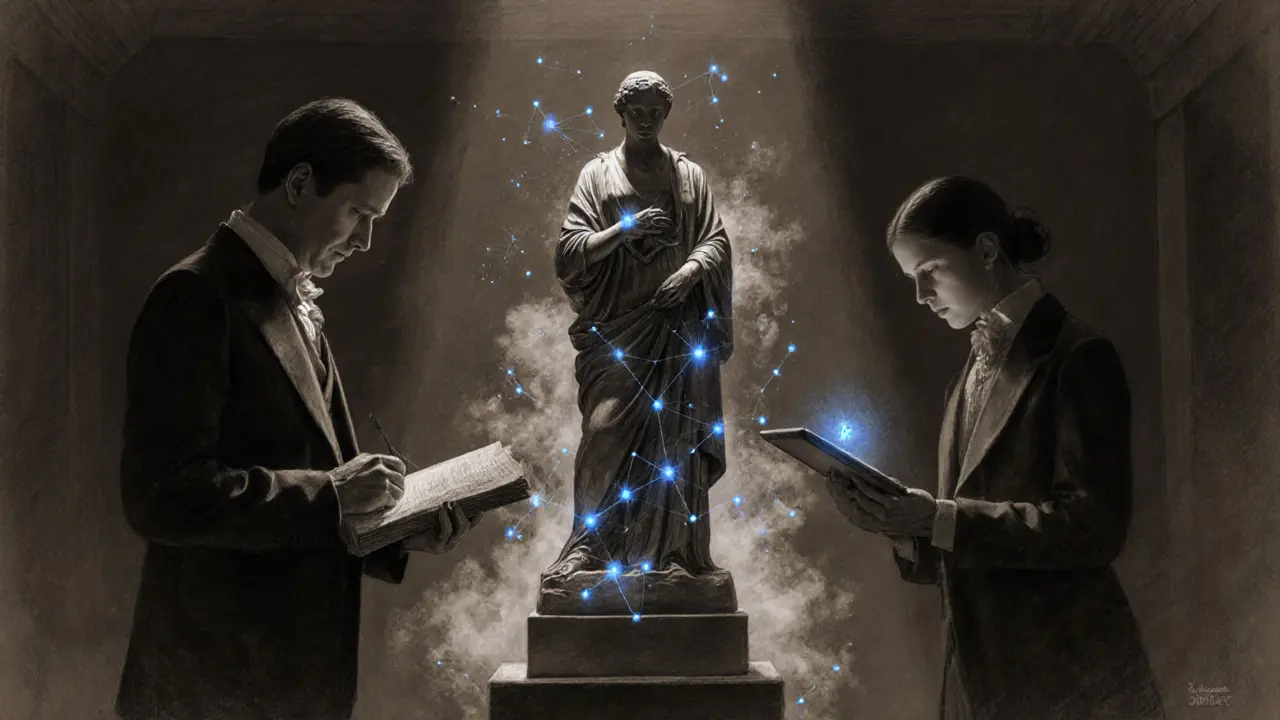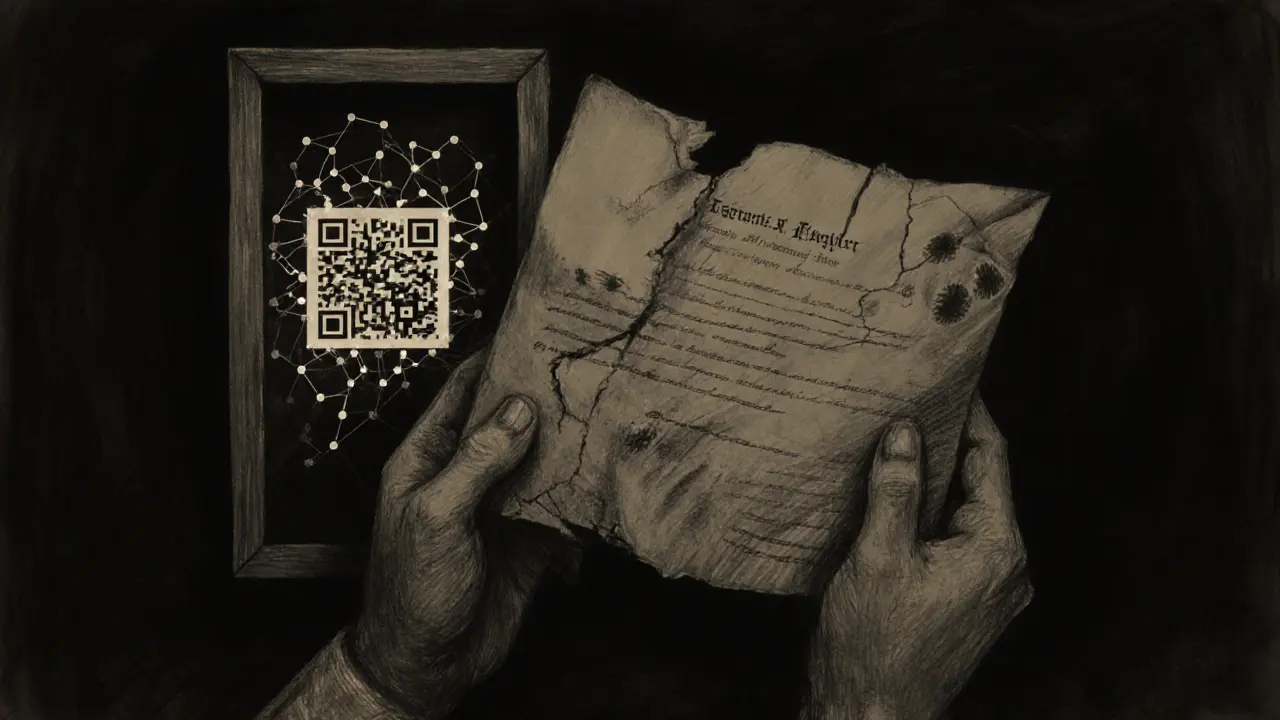Provenance Verification Comparison Tool
Authenticate Your Artwork
Enter details about your artwork to see how traditional authentication compares to blockchain provenance
Verification Results
Based on the information you provided, here's how authentication would work using both systems:
Why Blockchain Wins
With blockchain, each transaction is permanently recorded in an immutable digital ledger. Once verified, the art's history cannot be changed or erased without detection. This provides transparent, tamper-proof proof of ownership and authenticity that can be verified by anyone, anywhere, at any time.
Key Benefit: Blockchain authentication not only verifies if art is authentic, but provides complete provenance history that's impossible to forge.
Imagine buying a painting for $2 million, only to find out years later it’s a fake. Not a copy - a full forgery, complete with forged paperwork, fake signatures, and a history stitched together by con artists. This isn’t rare. It happens more often than you think. In 2024, a major auction house in London had to pull a $14 million painting from sale after blockchain verification revealed its provenance didn’t match the paper trail. The paper trail? It had been altered. The blockchain record? Unchanged since the artist signed it in 2008.
That’s the difference between blockchain provenance and traditional art authentication. One is a digital ledger that can’t be erased. The other? A stack of papers that can be lost, forged, or forgotten.
How Traditional Art Authentication Falls Apart
For centuries, proving a painting was real meant relying on experts - curators, art historians, dealers - who would examine brushstrokes, pigments, signatures, and old receipts. If you were lucky, you had a certificate from the artist’s estate or a gallery. But here’s the problem: those certificates can be faked. They can be lost in a fire. They can be sold separately from the artwork. And if the expert who signed off is no longer alive? Good luck proving anything.
Take the case of the 1980s “Pollock forgeries.” Over 60 paintings were sold as authentic Jackson Pollocks. Experts signed off. Galleries displayed them. Auction houses listed them. Years later, forensic analysis showed the paint wasn’t even available until after Pollock’s death. The paperwork? All forged. But by then, the paintings had changed hands three times. Who was liable? No one. The buyers lost millions.
Traditional systems also rely on fragmented databases. The Art Loss Register tracks stolen art. The Getty Provenance Index collects auction records. But they don’t talk to each other. A painting might show up in one system as “authentic,” but not in another because the paperwork was never uploaded. Or it was uploaded, but the file got corrupted. Or the database went offline for six months. No one knew. No one could fix it.
And then there’s insurance. Appraisers need proof of authenticity to value a piece. But if the only proof is a handwritten note from a dealer who died in 2001? Insurers won’t cover it. Or they’ll charge triple the premium. That’s not a market. That’s a gamble.
How Blockchain Provenance Works
Blockchain provenance flips the script. Instead of paper, you have a digital ID tied to the artwork - like a birth certificate that can’t be altered. Every time the painting changes hands, that change is recorded on a public ledger. Not just the buyer’s name - the date, location, condition notes, even photos of the back of the canvas. All of it is encrypted, timestamped, and stored across thousands of computers worldwide.
Here’s how it actually works:
- An artist or gallery registers the artwork on a blockchain platform like Verisart or Artory.
- They upload high-res images, materials used, dimensions, studio location, and a digital signature.
- A unique token - often an NFT - is created and linked to the physical piece.
- Every sale, loan, or restoration is added as a new block in the chain.
- Anyone can scan a QR code on the frame or visit the platform to see the full history - no permission needed.
It’s not magic. It’s math. Once data is added to the blockchain, it can’t be deleted or changed without breaking the entire chain - and that break is visible to everyone. No single entity controls it. No gallery, auction house, or dealer can rewrite history.
And here’s the kicker: smart contracts can be built into the token. If the artist wants 10% of every future resale, the system automatically sends it to their wallet. No lawyers. No disputes. No chasing down buyers years later.
Why Blockchain Beats Paper in 5 Key Ways
Let’s compare the two systems side by side:
| Feature | Traditional Authentication | Blockchain Provenance |
|---|---|---|
| Immutability | Paper can be forged, altered, or lost | Data cannot be changed without detection |
| Transparency | Only visible to those with access to files | Publicly verifiable by anyone |
| Decentralization | Controlled by galleries, experts, or archives | No single point of control or failure |
| Permanence | Files degrade, storage systems fail | Stored across global network - survives disasters |
| Automation | Manual verification, paperwork, signatures | Smart contracts handle royalties, transfers, access |
Let’s say you’re a collector in Singapore buying a sculpture from a New York studio. With traditional methods, you’d wait weeks for couriered documents, hire a local expert to verify them, and still have doubts. With blockchain? You scan a QR code on the sculpture’s base. In 3 seconds, you see: artist’s name, creation date, previous owners, restoration history, and current owner. All verified. All immutable. No middlemen. No delays.

Real-World Platforms Making It Happen
This isn’t theoretical. It’s already in use.
Verisart issues blockchain certificates for artists worldwide. A painter in Wellington can register a new piece in minutes. A buyer in Tokyo can verify it before paying. No more asking, “Is this real?” - just “Show me the record.”
Masterworks lets you buy fractional shares in blue-chip art like Warhol and Basquiat. Their blockchain system tracks who owns what percentage. When the painting sells, profits are split automatically. No paperwork. No delays. No disputes.
Maecenas goes further - it turns art into an asset class. Investors pool money to buy a painting, then earn returns when it’s resold. The blockchain handles ownership, transfers, and payouts. No bank. No broker. Just code.
Even Christie’s and Sotheby’s are testing blockchain for high-value sales. In 2023, Christie’s sold a digital artwork with a blockchain certificate that included every past owner - from the artist’s studio to the final buyer. The price? $4.2 million. The buyer? A 28-year-old from Melbourne who verified the chain on his phone before clicking “buy.”
Who’s Using This - And Who’s Still Holding Back
Younger collectors, tech-savvy artists, and institutional investors are adopting blockchain fast. Why? Because it reduces risk. And risk = money.
According to the Deloitte-ArtTactic Art & Finance Report 2023, 78% of high-net-worth buyers say provenance transparency is now their top concern when purchasing art. That’s up from 41% in 2019. Fraud is no longer just a scandal - it’s a financial threat.
But not everyone’s on board. Some traditional galleries still see blockchain as “tech noise.” They cling to handwritten ledgers and signed certificates because that’s how they’ve always done it. Others worry about complexity. “I don’t know how to use a wallet,” one dealer told me last year. Fair. But that’s changing. Platforms now offer simple apps - no crypto knowledge needed. Just upload, sign, and go.
Artists are the biggest winners. Before blockchain, most never saw a dime after their first sale. Now, with smart contracts, they earn royalties every time their work flips. A sculptor in Berlin made $18,000 in resale royalties last year - just from five pieces she sold in 2020.

What You Need to Get Started
If you’re an artist or collector, here’s how to start:
- Choose a platform: Verisart, Artory, or ArtChain are beginner-friendly.
- Take clear photos of the artwork - front, back, signature, materials.
- Register the piece with your name, date, and location.
- Link it to a digital wallet (most platforms guide you through this).
- Print a QR code and attach it to the frame or backing.
You don’t need to understand blockchain. You just need to use the app. Think of it like uploading a photo to Instagram - except this photo is your life’s work, and now it’s protected forever.
For collectors: always ask for a blockchain certificate. If they say, “We don’t do that,” walk away. Or at least hire a forensic art specialist - and hope they don’t miss the forgery.
What’s Next?
Blockchain won’t kill traditional authentication overnight. Experts will still be needed for style analysis, pigment dating, and historical context. But their role is changing. They’re no longer the gatekeepers of truth. They’re now auditors - verifying what the blockchain already proves.
The art market is slowly waking up. Fraud is too expensive. Trust is too fragile. And now, there’s a better way.
In five years, asking for a paper certificate might be like asking for a fax copy of a contract. It’s not illegal. It’s just… outdated.
Can blockchain prevent all art fraud?
No system is 100% foolproof. Blockchain protects the record, not the object. A thief could still steal a painting and sell it without the QR code. But they can’t fake the ownership history. Buyers who check the blockchain will know the piece they’re seeing doesn’t match the record - and that stops most scams before they start.
Do I need cryptocurrency to use blockchain provenance?
Not at all. Most platforms let you pay with credit cards. The blockchain runs in the background - you never touch crypto unless you want to. It’s like using PayPal: you don’t need to understand how the bank network works to send money.
What happens if the blockchain platform shuts down?
The data isn’t stored on the platform - it’s on the blockchain, which is decentralized. Even if Verisart disappears, the records still exist on public ledgers like Ethereum or Polygon. Anyone can access them using the artwork’s unique ID. Think of it like email: if Gmail shuts down, your messages are still on the server. You just need another app to read them.
Can I register old artwork on blockchain?
Yes. Many platforms allow retroactive registration. You’ll need as much documentation as possible - old receipts, exhibition records, photos, or expert opinions. The blockchain won’t verify the artwork’s age, but it will lock in your version of its history from now on. That’s better than nothing - and far more reliable than a faded certificate.
Is blockchain provenance only for digital art?
No. It’s used for physical art too - paintings, sculptures, installations. The NFT or digital certificate links to the real object, not replaces it. Think of it as a digital twin. You still hang the painting on your wall. You just know its full story with one scan.

